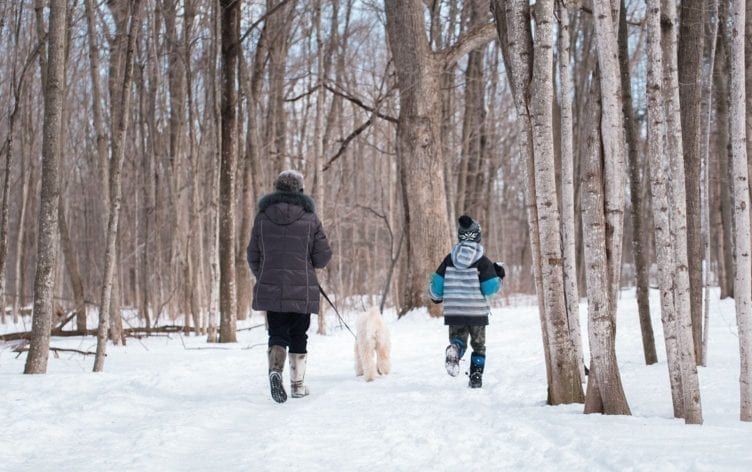
10 Cold-Weather Walking Mistakes to Avoid
When it’s cold, extra precautions are necessary to keep your daily walks safe and fun. The good news is, walking through the winter months is doable as long as you adjust your habits and consider a few additional things when the temperatures plummet.
From braving potentially dangerous conditions to upping your traction, here are 10 winter mistakes you should avoid while walking outdoors as you wait for warmer weather to arrive this spring.

Without a doubt, there are times in the winter when it’s safer and more convenient to walk indoors. While you can certainly find suitable alternatives to walking outdoors, you shouldn’t avoid walking outside. In fact, walking outdoors has benefits over indoor walking, including:
- Boosting your mood and helping with depressive symptoms
- Less exposure to viruses common in indoor environments
- Varying terrain forces you to recruit from different muscle groups.
- Improves proprioception and helps strengthen tendons and ligaments

Just because it’s cold and overcast doesn’t mean you can’t get sunburned. On those days when you’re spending more than 30 minutes outdoors on your walk, apply sunscreen to any exposed skin just as you would during the summertime — even if it’s only your face and ears. This protects you from harmful UV and UVA light that can be bad for your skin and health, and lead to things like premature aging, wrinkles, sunspots, and, in extreme cases, skin cancer.

Even though you sweat more in warmer conditions, sweating and losing water during exercise still occurs during the winter. While you may not need extra fluid unless you’re walking for more than 60 minutes at a moderate intensity, making sure you’re hydrated before your walks, and rehydrating post-walk is still necessary. Since the air is typically drier during the winter, carrying a handheld bottle with you and drinking to thirst generally allows you to be more comfortable and enjoy your time outdoors.

Hitting an unfamiliar trail and getting lost can be a big deal during the winter, as hypothermia can set in quickly. Even if you know the trail or route, during the winter, certain roads and trails might not be as well maintained as they are in the summer and can be much more dangerous. For this reason, it’s always safer to stick to what you know and choose routes located on well-maintained trails and roads to stay safe.

Dress too warm, and you run the risk of sweating too much and overheating. Underdress, and you’ll expose yourself to cold or wet environments that increase your risk for hypothermia. While it can be difficult to get right, layering is the key to winter walking. Instead of a bulky jacket and a T-shirt, using multiple layers that are thinner, moisture-wicking, and easier to remove and adjust to the temperature is key. Here are a few tips to get it right:
- Wear a base layer: A good base layer wicks away moisture as you sweat, keeping you dry and warm.
- Choose your middle layer based on the temperatures. A thin garment made of a material like merino wool is a good choice because it wicks away sweat and can keep you warm without overheating.
- Use your outer layer to protect against the conditions: A shell that is water repellent and protects you from the wind is necessary for cold and wet climates. Lighter options are generally better than heavier jackets, as you can always add or remove a layer beneath your shell.

While layering the core is important, it’s not all you need to worry about. The head, in particular, is one bodypart you want to keep covered on those really cold days, as the body heat you create during your walk can be lost through the head and neck. For this reason, a hat or lightweight beanie is usually recommended.
Keep in mind, too, that during the winter, your circulation is worse, particularly the harder you exercise, and makes your hands feel even colder. Wearing mittens helps with this a great deal, and they can easily be removed if you get hot later on during your workout.

There are times when walking outdoors may not be worth the risk. Whether it’s a snowstorm, temperatures plummeting below freezing or icy sidewalks, it’s good to have a backup plan instead of braving dangerous conditions. For those times when walking indoors is your safest option, here are a few ideas you can try:
- Treadmill
- Indoor track
- Mall walking
- A walking workout video

In moderate conditions, you might be able to get away with regular walking or running shoes during your workout. But for those times when you venture to areas where there may be ice, snow or hazardous trail conditions to deal with, it’s a good idea to adjust your traction as necessary. This can include:
- Trail shoes with a grippier outsole on snowy trails
- Walking poles for additional balance and traction
- Crampons or snowshoes for icy and minimally maintained trails

Moving from a warm house to chilly outdoor environments can be quite a shock to the system. Jumping right into a workout without giving your muscles time to warm up first can also make an injury more likely. For this reason, completing a few dynamic exercises inside before stepping outside can help get your blood flowing, make you feel less cold when you step outside, and ensure your muscles are ready for your workout.
Here are a few ideas:
- 2–3 minutes of jumping jacks
- 20–30 squats or lunges
- Marching in place for 5 minutes

While this can be a problem any time of year, it’s more likely you’ll indulge in warm beverages and other treats that are high in calories and low in nutritional value during the winter — particularly after you settle down post-workout. To meet your weight-loss goals and recover from your workout properly, avoid sweets and the resulting spikes in your blood sugar, and replace what you’ve lost from exercise with nutritious options. Healthy stews and nutrient-packed soups are a great, tasty way to warm up post-workout.
Check out “Workout Routines” in the MyFitnessPal app to discover and log workouts or build your own with exercises that fit your goals.

































